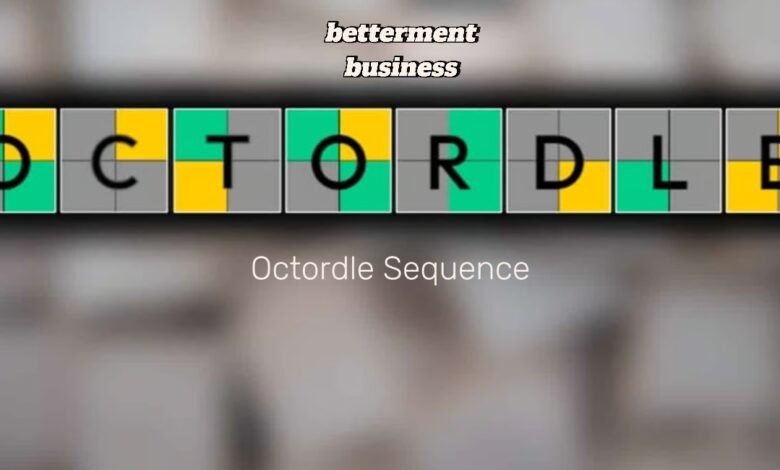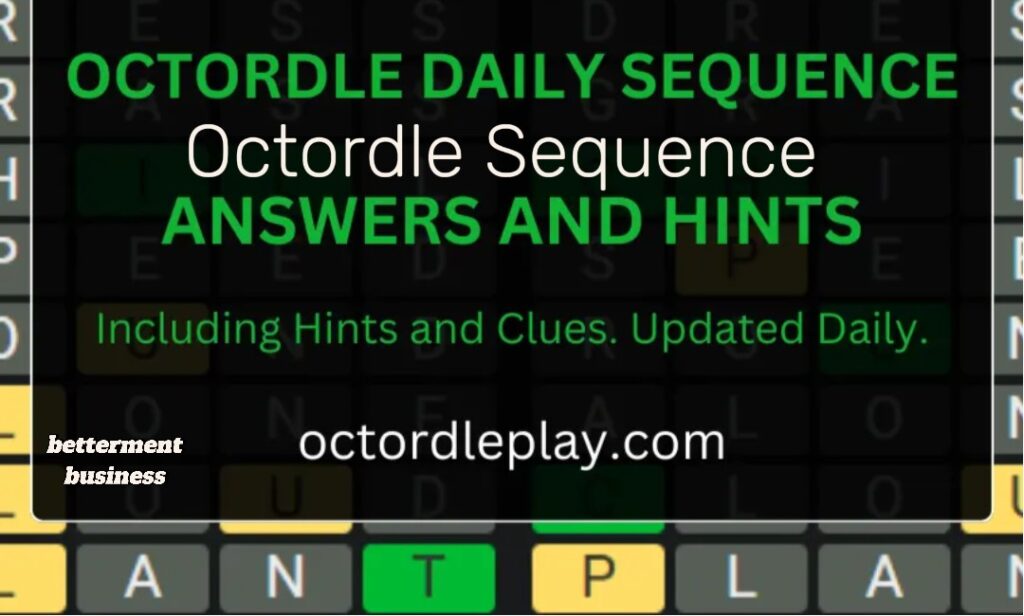The Intricate Dance of Deduction: Understanding the “Octordle Sequence”

The digital age has ushered in a golden era for word puzzles, Octordle Sequence games like Wordle capturing the imagination of millions. Yet, for those seeking an amplified challenge, a more complex cognitive workout, the landscape extends far beyond a single five-letter solution. Enter Octordle, a demanding variant that requires players to solve eight distinct five-letter words simultaneously, using only six guesses per word. Within this intricate system lies the crucial concept of the “Octordle sequence” – a strategic, multi-layered approach to guessing that dictates success or failure. It’s not merely about finding the right letters; it’s about the calculated order, the logical progression, and the intelligent application of information gained across multiple simultaneous challenges.
What is Octordle Sequence? The Foundation of the Sequence
Before delving into the “sequence” itself, it’s essential to grasp Octordle’s core mechanics. Players are presented with a grid divided into eight smaller, identical Wordle-style grids. Each grid represents a separate five-letter word that needs to be guessed. The player enters a five-letter word, and this single guess is applied simultaneously to all eight grids. The feedback is immediate:
- Green: The letter is correct and in the correct position in that specific word.
- Yellow: The letter exists in the word but is in the wrong position.
- Gray: The letter does not appear in the word at all.
The objective is to correctly guess all eight words within the six-guess limit applied across the board. This simultaneous nature is what elevates Octordle from a simple word puzzle to a complex exercise in simultaneous deduction and strategic sequencing.
Deconstructing the “Octordle Sequence”: A Multi-faceted Strategy
The term “Octordle sequence” encompasses several interconnected layers of strategic thinking:
1. The Guess Sequence: Order Matters
This is perhaps the most literal interpretation. In Octordle, the order in which you choose your guesses is critical. Unlike Wordle, where a suboptimal guess might cost you one attempt, in Octordle, a poorly chosen guess can be detrimental across multiple grids, potentially eliminating valuable letters or consuming attempts needed for specific, more challenging words.
- Opening Strategy: The initial guesses are crucial for information gathering. Players often start with words containing common vowels (like A, E, I, O, U) and frequently used consonants (like R, S, T, L, N). The goal isn’t necessarily to solve a word early, but to gain as much information – green, yellow, and gray tiles – across as many of the eight grids as possible. A strong opening sequence might involve two or three diverse words designed to test a wide range of common letters. For example, starting with “RAISE” might reveal common letters and their positions, followed by “CLOUT” to test different consonants and vowels, and perhaps “SPEND” to cover more ground. The sequence here is about maximizing the breadth of letter coverage in the initial attempts.
- Information Gathering vs. Elimination: Early guesses focus on broad information gathering. As clues accumulate (greens and yellows), the sequence shifts towards elimination. A player might notice that several words contain ‘S’ and ‘T’ but lack ‘E’. The next guess might be tailored to test specific combinations or letters that haven’t appeared yet, prioritizing grids that are furthest behind or seem particularly challenging. The sequence evolves from broad sampling to targeted interrogation.
- Prioritizing Grids: Sometimes, a player might identify one or two grids that are significantly easier or harder than the others. The subsequent guess sequence might prioritize gathering more clues for the difficult grids, or using a guess that helps solve multiple simpler grids simultaneously, freeing up mental capacity.

2. The Letter Sequence Within Guesses:
This refers to the arrangement of letters within a single five-letter guess. The sequence of letters matters because it impacts how quickly you can deduce word patterns.
- Common Letter Placement: Placing frequently occurring letters like ‘E’ or ‘S’ in potential common positions early on can yield valuable information. However, overcrowding a guess with the same common letters might be less efficient than diversifying.
- Avoiding Redundancy: In the initial guesses, using words with unique letters (e.g., “CRANE” vs. “TRACE”) maximizes the potential for revealing new letters. Repeating letters too early, unless specifically testing a hypothesis (like “LLAMA”), can waste a valuable guess slot if those letters are incorrect.
- Testing Vowel/Consonant Balance: A good guess sequence involves balancing vowel and consonant tests. For example, if the first guess was heavily consonant-based, the next might focus on vowels or vice-versa, depending on the feedback.
3. The Grid Interaction Sequence:
This is where Octordle’s complexity truly shines. The eight grids are not entirely independent; they influence each other through the shared guessing mechanic.
- Shared Knowledge: A guess that yields three green letters in one grid might provide critical context for another grid that shares some of those letters. For instance, if Grid A requires a word starting with ‘T’ and ending with ‘E’, and Grid B needs a word with ‘T’ but not in the first position, a guess like “TABLE” could provide crucial feedback for both. The sequence involves recognizing these interdependencies and leveraging them.
- Elimination Across Grids: If a letter appears gray in five grids, it’s highly probable, though not guaranteed (due to duplicate letters in words), that it’s also gray in the remaining three. Smart players mentally (or physically) track which letters are definitively ruled out across the majority of grids to inform subsequent guesses.
- Solving Clusters: Sometimes, multiple grids might converge on similar possibilities (e.g., words ending in -IGHT, -OUND, -ATCH). A sequence of guesses might be designed to systematically test these variations across all affected grids.
4. The Information Reveal Octordle Sequence:
This refers to how players process and interpret the feedback received after each guess. It’s a cognitive sequence involving observation, memory, and logical deduction.
- Simultaneous Processing: The brain must track the state (green, yellow, gray) of potentially eight different words concurrently. This requires significant cognitive load and a systematic approach.
- Pattern Recognition: Players look for patterns in the feedback. Are yellows consistently appearing in the same relative positions across grids? Are certain letters universally grayed out? This pattern recognition fuels the deduction process.
- Hypothesis Generation and Testing: Based on the revealed sequence of colors and letter placements, players formulate hypotheses about potential words for each grid. The subsequent guess sequence is then built around testing these hypotheses efficiently.
Strategic Approaches to Mastering the Octordle Sequence
Conquering Octordle requires more than just luck; it demands a deliberate strategy that embraces the concept of sequencing:
- The “Universal” Opener: Many players develop a set of 2-3 “universal” starting words that aim to cover the most common letters and their potential positions efficiently. Words like ADIEU, STARE, RAISE, CRANE, LOUSE, AUDIO, ROATE are popular choices because they contain a good mix of vowels and common consonants without repeating letters initially. The sequence of these openers is key.
- Leveraging Duplicate Letters: Once common letters are identified, players must be strategic about using words with duplicate letters (like ‘LL’, ‘EE’, ‘SS’). Guessing “QUEUE” might be useful if ‘Q’ and ‘U’ are suspected, but it requires careful consideration of whether the duplicate ‘U’s are necessary tests across multiple grids.
- Thinking About Word Endings and Beginnings: Certain letter combinations are more common at the start or end of words. A sequence might involve guesses that probe these common patterns, especially when multiple grids show partial progress.
- The Power of Elimination: As gray letters accumulate, they become just as important as green or yellow ones. A successful sequence involves systematically eliminating possibilities based on confirmed absent letters.
- Contextual Clues: Sometimes, the nature of the words themselves can offer clues. If the game includes words like “BRAVE,” “SHAVE,” and “CLAVE,” the player knows these variations are within the potential solution pool.
The Psychological Appeal: Why We Embrace the Complex Octordle Sequence
Octordle’s appeal lies in its demanding nature. It taps into several psychological drivers:
- Cognitive Challenge: The sheer mental effort required to track eight simultaneous games provides a robust cognitive workout, stimulating pattern recognition, memory, and logical reasoning.
- Sense of Accomplishment: Successfully solving all eight words within the limited guesses offers a profound sense of achievement and intellectual satisfaction. It’s a victory over complexity.
- Vocabulary Expansion: Players inevitably encounter and learn new five-letter words through the game, subtly expanding their vocabulary.
- Mastery and Strategy: The emphasis on developing and executing a successful “Octordle sequence” appeals to the desire for mastery and strategic thinking. Players enjoy refining their approach and finding more efficient ways to solve the puzzle.
- Community and Comparison: While harder to share directly than Wordle, players still find camaraderie in discussing strategies, comparing successful sequences, and celebrating tough wins.
Octordle’s Place in the Word Game Hierarchy
Octordle sits firmly in the “hard mode” category of the Wordle-inspired genre. It follows games like Dordle (two words) and Quordle (four words) as a step up in difficulty. Beyond Octordle lies Sedecordle (sixteen words), pushing the complexity even further. Octordle strikes a balance – it’s significantly more challenging than its predecessors but perhaps more manageable for many than the extreme complexity of Sedecordle. The specific number eight creates a unique strategic puzzle, requiring a different blend of broad coverage and targeted deduction than games with fewer or more simultaneous words.
Conclusion: The Art and Science of the Octordle Sequence
The “Octordle sequence” is far more than a simple game plan; it is the embodiment of strategic thinking applied to a complex, multi-layered puzzle. It involves the careful ordering of guesses, the intelligent arrangement of letters within those guesses, the recognition of interdependencies between the eight simultaneous challenges, and the effective processing of feedback. Mastering Octordle is a testament to a player’s ability to manage cognitive load, employ logical deduction, and adapt their strategy dynamically. It’s a rigorous, rewarding mental exercise that appeals to anyone who enjoys a good challenge and the deep satisfaction of cracking a complex code, one calculated sequence at a time.
Also Read This Chipotle Calorie Calculator



